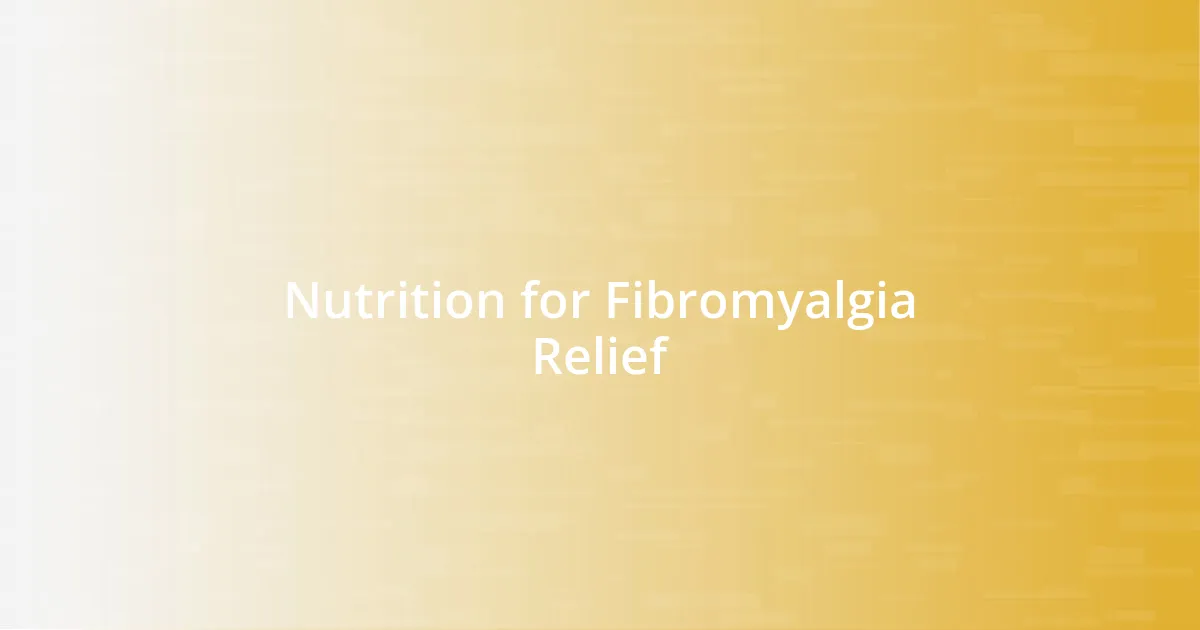Key takeaways:
- Fibromyalgia symptoms include deep muscle pain, cognitive issues (fibro fog), and sleep disturbances, impacting overall well-being.
- Identifying personal triggers (like food and stress) through journaling allows for proactive management of symptoms.
- Regular gentle exercise and mindfulness practices help alleviate pain and improve mental health.
- Building a support network with friends, family, and support groups enhances emotional resilience and coping strategies.

Understanding Fibromyalgia Symptoms
Fibromyalgia symptoms can often feel like an unpredictable rollercoaster, right? I remember days when a simple task like getting out of bed seemed monumental. The deep muscle pain, fatigue, and widespread tenderness weren’t just physical—they weighed heavily on my spirit, making it tough to maintain a positive mindset.
What surprised me most about fibromyalgia was the cognitive symptoms, often dubbed “fibro fog.” I once found myself struggling to recall my best friend’s name during dinner; the embarrassment was overwhelming. It’s like my thoughts were wrapped in a thick fog, and that feeling of confusion made me wonder if others could see the distress I was masking.
Alongside the pain and mental fatigue, sleep disturbances constantly tested my patience. I used to lay awake for hours, longing for a restful night, but all I got was a restless mind. Have you ever felt that way? The frustration of waking up not refreshed, but more exhausted, can be a particularly isolating piece of this journey.

Discovering Personal Triggers
Discovering what triggers your fibromyalgia flare-ups can feel like trying to solve a complex puzzle. I’ve found that certain foods, stressors, and even weather changes can dramatically influence my symptoms. For instance, I once consumed a seemingly harmless salad with high-sugar dressing, and the next day, I was in excruciating pain. It made me realize how essential it is to keep a close eye on what I consume and how it makes me feel.
Keeping a detailed journal has transformed my understanding of these triggers. Each time I experience a flare, I jot down my activities, dietary choices, and emotional states leading up to it. This habit has allowed me to pinpoint that stress from social situations or a lack of sleep directly correlates with an uptick in my symptoms. Have you ever noticed any patterns? Finding these connections has not only empowered me but has also encouraged a proactive approach to managing my fibromyalgia.
One thing I’ve learned is that identifying my personal triggers is not a one-off task; it’s an ongoing process. I still experience surprises along the way. Recently, I discovered that a change in my evening routine, like skipping my relaxation yoga, led to a week of increased tension and discomfort. Each small breakthrough or setback teaches me more about my body and its needs.
| Trigger Type | Personal Experience |
|---|---|
| Foods | High-sugar dressings caused flare-ups. |
| Emotional Stress | Social situations often lead to increased symptoms. |
| Sleep Routine | Skipping evening yoga led to discomfort. |

Effective Pain Management Techniques
When it comes to managing pain from fibromyalgia, I’ve discovered that a combination of techniques can make a world of difference. One method that’s become invaluable for me is gentle exercise, like swimming or tai chi. Not only do these activities help alleviate some of the agony, but they also provide a sense of accomplishment that boosts my mood. Each movement feels like a reminder that I can still enjoy life, even on tough days.
- Regular gentle exercise (e.g., swimming, tai chi) helps reduce pain and improve mood.
- Heat therapy, such as warm baths or heating pads, offers immediate relief for sore muscles.
- Mindfulness practices, like meditation and deep breathing, help me find moments of peace amidst the pain.
- Over-the-counter pain relievers, when used responsibly, can be effective in managing daily discomfort.
Another approach that’s profoundly impacted my journey is the incorporation of complementary therapies. I vividly remember my first acupuncture session; I walked in feeling heavy and drained, but emerged with a lightness I hadn’t felt in ages. This therapy seemed to awaken my body, creating pathways for relief where I felt none existed. Exploring options like massage therapy or aromatherapy has also been a delightful experience, making me feel more connected to both my body and my emotions.

Incorporating Regular Exercise
Incorporating regular exercise into my daily routine has been a game changer for managing fibromyalgia. On days when I feel particularly fatigued, just taking a short walk around the block feels like a monumental achievement. I often find myself asking, “How can something so small feel so empowering?” That gentle movement helps to shake off the fog and reminds me that I’m capable of more than I sometimes believe.
I’ve discovered that consistency is the secret sauce. For me, scheduling light workouts, like yoga or dancing in my living room, has transformed my perspective on exercise. There was a week when I committed to this routine every evening, and I noticed that my energy levels surprisingly soared. It’s almost like I can hear my body whispering gratitude in response to the care I’m giving it. Can you relate to that sensation of your body responding positively to kindness?
There’s an undeniable connection between my mental state and physical activity. I remember a particularly gloomy day when I forced myself to stretch and breathe deeply. At first, I scoffed at the idea that a few simple movements could alter my mood. But soon, I was smiling—how exhilarating it felt to let go of tension! Have you ever experienced that shift? When I take those small steps, I realize that exercise is more than just physical; it’s a vital thread weaving together my emotional and mental well-being.

Nutrition for Fibromyalgia Relief
Nutrition for Fibromyalgia Relief
When it comes to nutrition, I’ve learned that the foods I choose can significantly impact my fibromyalgia symptoms. For example, I’ve noticed that incorporating more anti-inflammatory foods, like salmon and leafy greens, has made a remarkable difference in my overall well-being. Have you ever felt the boost that a healthy meal can give you? I certainly have, especially those days when I prioritize nourishing my body with wholesome options.
One surprising discovery for me was the effect of eliminating processed sugars and refined carbohydrates. I vividly recall a week where I decided to cut back on snacks loaded with sugar, and the change was almost immediate. Not only did I experience less brain fog, but my energy levels felt more stable. It’s interesting how something so simple can have such a profound effect—have you tried adjusting your diet in similar ways?
Finally, I can’t emphasize enough the importance of hydration. There were days when I’d forget to drink water and found myself feeling even more fatigued and achy. Now, I make it a point to keep a water bottle close at hand, reminding myself that hydration is key in managing my symptoms. After all, what good is all the good food without the right balance of fluids to help your body function? Paying attention to these small details has really made my nutritional choices feel empowering.

Mindfulness and Stress Reduction
Embracing mindfulness has been a revelation in my journey with fibromyalgia. When I first tried meditation, I thought, “Can merely sitting still really make a difference?” To my surprise, I found that dedicating just ten minutes each morning to focused breathing helped ease the swirling chaos in my mind. It was like giving my brain a mini-vacation, allowing me to enter the day with a clearer perspective. Have you ever taken that moment to just breathe and feel the present?
I also rely on mindfulness techniques during moments of overwhelming stress. There have been days when my pain threatened to spiral my mood downwards, and that’s when I consciously pause to engage my senses. I’ll notice the texture of my blanket, breathe in the scent of a calming essential oil, or listen to the gentle hum of nature outside. In those moments, I gently challenge myself: “What can I learn from this pain?” It fosters a sense of acceptance that lightens my emotional burden. How do you navigate your own challenging feelings?

Building a Support Network
Building a support network has been instrumental in managing my fibromyalgia. Initially, I didn’t think reaching out would make much of a difference. But when I shared my struggles with friends and family, I found unexpected empathy and understanding. Have you ever experienced that heartwarming relief when someone simply listens? I’ll never forget the moment my best friend acknowledged my pain, validating my feelings and reminding me I wasn’t alone in this battle.
Connecting with others facing similar challenges has also been a game-changer. I joined a local support group and was amazed by the bond we quickly formed. One evening, we shared not just our pain stories, but also laughter and coping strategies—like how to manage flare-ups during a family gathering. I remember one member sharing her tip about using heat packs secretly during dinner; it was a small solution that brought us closer together. The understanding we exchanged felt like a warm hug, one that I didn’t realize I desperately needed.
Lastly, I believe that professionals can be invaluable in this journey. Therapists and counselors provide a safe space for expressing frustrations related to fibromyalgia. When I met with my therapist, it felt liberating to discuss not just the physical pain but the emotional toll it took on me. I learned the importance of setting boundaries and surrounding myself with people who understand my limits. Have you ever thought about how integral supportive relationships are in healing? I found that these connections paved the way for resilience and hope, allowing me to thrive rather than just survive.















